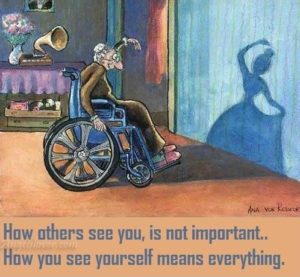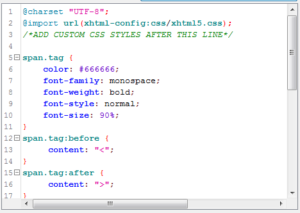Don’t Try To Change Your Habits, Change Your Self-Image
 It can be a struggle to change your habits. We’ve all tried to do it again and again, and often without very much success. It seems to be quite a difficult thing to do. And that’s because we’re trying to change something outside of ourselves. There’s an easier way actually, and a way that’s far more effective. Instead of trying to change the habits that define you, change the essential you that has those habits.
It can be a struggle to change your habits. We’ve all tried to do it again and again, and often without very much success. It seems to be quite a difficult thing to do. And that’s because we’re trying to change something outside of ourselves. There’s an easier way actually, and a way that’s far more effective. Instead of trying to change the habits that define you, change the essential you that has those habits.
You want to exercise more. Preferably regularly. But it’s a struggle to develop that habit, because that’s just ‘not you’. You don’t feel like a person who trains regularly, so trying to force yourself to act like one is uphill work all the way. But how about if you approached it from a different angle … instead of trying to exercise regularly, why not start by seeing yourself as a person who does exercise regularly.
Change how you see yourself
I know, it sounds like a picky kind of distinction, but it’s actually a very important one. Right from when you were a very young child you’ve been creating and refining a blueprint of the kind of person you are.
 You mentally see yourself as a kind person, and maybe, in certain circumstances, not so kind … as a generous person, or maybe someone who’s secretly a bit stingy. You see yourself as quite lazy … although you’d like to be more active … even athletic. And you see yourself as not gifted at all as far as writing goes, or playing music … or then again, maybe you are a writer, or a musician.
You mentally see yourself as a kind person, and maybe, in certain circumstances, not so kind … as a generous person, or maybe someone who’s secretly a bit stingy. You see yourself as quite lazy … although you’d like to be more active … even athletic. And you see yourself as not gifted at all as far as writing goes, or playing music … or then again, maybe you are a writer, or a musician.
Whatever you see yourself as, that’s what you are. Because it’s your subconscious mind’s job to keep you in sync with your mental image of yourself. You need to stay true to yourself at all times, no matter what. And your subconscious mind will see to it that you do. That’s its job, and it will do it faithfully, whether or not it happens to be in your best interests.
This is why it can be so frustratingly hard to keep up a fitness routine if it’s just ‘not you’. You’re trying to force yourself to do something that contradicts your self-image, and that always leads to problems. The trick is to change your self-image. And yes, it can be done. Your self-image isn’t fixed in stone, permanent and unchangeable.
Your self-image is your personal style sheet
 As I already said, it’s a mental blueprint. A sort of aggregation of all the things you believe about yourself. If you’ve ever used CSS to help design a web page, it’s a bit like that. CSS is a style sheet, a collection of all the different aspects of the page. There’s a rule that defines the size of the headline and maybe the colour of it, one that defines the size of the body text, another that defines the background colour of the page, one that defines how much space is left between paragraphs, and so on, a whole list of little individual rules.
As I already said, it’s a mental blueprint. A sort of aggregation of all the things you believe about yourself. If you’ve ever used CSS to help design a web page, it’s a bit like that. CSS is a style sheet, a collection of all the different aspects of the page. There’s a rule that defines the size of the headline and maybe the colour of it, one that defines the size of the body text, another that defines the background colour of the page, one that defines how much space is left between paragraphs, and so on, a whole list of little individual rules.
Once that style sheet is written and attached to the page, the page will look a certain way. It can’t look any other way. It literally cannot. There’s no leeway. The page can’t unilaterally decide to present itself differently from its CSS style sheet. It must refer to the CSS rules to see how to present itself onscreen. That’s how it works.
And it’s the same with your self-image; your subconscious mind refers to the self-image constantly when you’re going about your normal day, just as your computer does when a page is called up to be displayed. The HTML code for the page refers to the CSS style sheet and displays the page in line with the rules. It cannot be any other way.
And you, whenever you’re in a new situation, your subconscious mind refers to your self-image (in effect, your own personal style sheet) and sees to it that you present yourself in accordance with the image you have of yourself.
This is the secret of self-confidence
That’s why confident people feel at ease in company, even if they have to address a group, or an audience. They’re just acting in line with their self-image. They have a belief that they can handle such situations, so it’s quite straightforward for them to do so.
And it’s why a guitarist can pick up a guitar anywhere, in a music shop, at a party, wherever, and start to play it, confident that everything will go well. And of course it’s why you, if you’re not a very confident person, can feel absolutely dreadful at the thought of meeting new people, or going to a social gathering … because you see yourself as inadequate, or lacking in self-confidence. You’re just acting in a way that tallies with your strongly held beliefs, that’s all.
Why is this important?
Why is it important enough for me to go on about this in detail? Because now that you know, for a fact, that the self-image is a malleable mental construct, you’re empowered to change it, if you so desire.
You can make yourself more confident, more outgoing. You can make yourself good at learning languages. You can make yourself adept at learning to play an instrument. Because each of these things is just a strongly held belief. And if you change your beliefs about yourself, you automatically change your self-image.
So don’t just carry on struggling to try to stick to a tough fitness regime that feels really alien to you. Instead, change the way you see yourself. Come up with a few affirmations that encapsulate the new you. Something like …
- “I enjoy training … it makes me feel good”, or
- “I train every day, because that’s just who I am!”, or
- “I love the way I feel when I’m training – I feel totally alive and exhilarated”
You might feel a bit strange saying things like this to yourself, since these phrases appear to contradict the truth, but just go along with it. Repeat them to yourself time after time, at various times of the day, and pretty soon they will start to sink in to your consciousness. You’ll actually start to believe them! Like Muhammad Ali said, “I was telling people I was the greatest long before I even believed it myself”.
Make your affirmations come alive … make them vivid!
Use your affirmations often, and with emotion. As soon as you feel able, say them to yourself with feeling, as though you really mean it. And don’t just leave them as empty words, invest them with imagery and action. See yourself exercising. See yourself fitter and healthier. See yourself enjoying your workouts. Make your mental images as clear and vibrant as you can manage, and employ your other senses as well, not just sight.
Mentally hear the sounds of the gym – the clank of the heavy disks being put on weights bars, the murmur of conversation among the other people training – and try to smell the environment, imagine the feel of the training bench, the handles of the machines, the bars … everything.
The more you enliven these mental images and scenes, the quicker you’ll actually believe what you’re saying. And that’s when you’ll really start to feel energised at the thought of training, and start to look forward to your workouts instead of dreading them.
